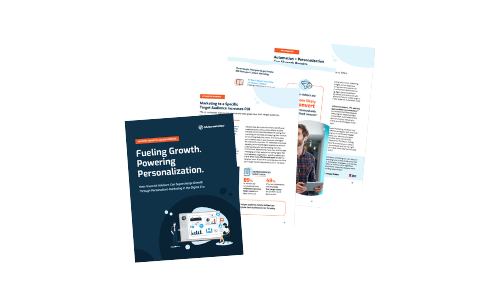Finances are your forte, so things like UX and UI can seem, well, kind of like a complex computer language.
However, if you are looking to generate more leads with your website, you need to optimize it with these two in mind.
We are not saying that you need to become a website designer, but gaining some basic knowledge of how user experience (UX) and user interface (UI) work can do wonders for your online presence.
Both of these are the basis for strong financial marketing, they optimize your website to perform well.
Why is this important?
It’s because people are more reliant on the internet for financial solutions than ever before.
Nearly half of financial clients these days view at least 3 to 5 pieces of content online before they make a decision.
They’ll do their due diligence and research you online before they even consider you for your expertise.
Many think that UX and UI represent the same thing.
The two intertwine to optimize your marketing strategy, but they are different at the core.
In this post, we’ll unpack the details of these terms and show you how to use them to deliver a top-notch experience to the users of your financial services.
Website UX and UI Explained For Financial Advisors
What Is UX?
Think of it this way.
Your online financial marketing is made of digital experiences.
Each of them has a specific purpose.
Your website, for example, can be used to show clients who you are, what you do, and why you are the right fit for them.
The CTAs on your site guide visitors to take actions like downloading your resources, reading your blog, and hopefully, contacting you.
User experience or UX is all about making these function properly to allow clients to reach their goals. This way, when a client wants to get from point A to point B on your website, they’ll do this with ease.
The user experience is a top priority for 73% of financial service marketers, with 3 out of 4 financial marketers considering this one of the most important things.
Let’s go through the elements of UX design:
- How users find your financial services
- The actions users take to fulfill their needs
- How fast they can do this
- The overall quality of experience
- The user satisfaction with the interactions
What Is UI?
While UX is about functions, UI is about aesthetics.
UI refers to the user interface.
You can’t just throw financial information throughout your website hoping visitors will find their way around your content or know exactly what action to take.
When you design the UI, you need to make the journey enjoyable and efficient for clients.
Let’s go through the elements of UI design now:
- Functionality elements like buttons, drop-downs, check boxes, etc.
- Visual elements like colors, videos, and images
- Animation
- Action-consequence: what happens when the user drags, clicks or swipes, for example
- How adaptable your pages are to different screen sizes (mobile responsiveness)
How To Use UX & UI To Transform Your Financial Marketing
Your responsibility as a financial advisor is to inform and advise your clients on what actions to take in terms of their money.
But, you have another responsibility if you want your website to work in attracting clients - you need to optimize it for UX and UI.
Here are the 2 vital steps to help you accomplish this:
Step 1: Build A User Journey Map
As a business finding clients online, you'll need to transform the user experience into something more pleasurable and simplified.
The first step in optimizing your financial marketing products for UI and UX is to build the journey of your users.
Create a user journey map to learn about the experience of your target audience when they use your website or app.
Based on this, you can better understand their goals, polish the things that don’t work well, and optimize the experience.
It’s very easy to become nearsighted when you’re editing your own website or app.
This is something you are attached to or something you’ve been looking at for a long period of time.
If you want to optimize it for potential clients, you need to learn to view it how they view it.
A user journey map will help you to do exactly that, pinpointing the pain points that escaped you before.
Step 2: Redesign your website
Based on the results from your user journey map, you'll need to edit certain aspects of your website, or even redesign it completely.
Digital Operating Solutions summarizes it best with 11 main reasons why you should redesign your website. For convenience, we've added the bullet points below.
Note that most of these are related to the user experience and the functionality of your site.
- You don't have a lot of traffic
- Your site is not user friendly
- Your brand has evolved and is no longer reflected on your website
- Your site is not mobile-friendly
- You're not keeping up with current trends
- It doesn't have any interactive features that prompt action
- Your content is outdated
- Your website design is outdated
- The message is unfocused and unclear
- Your site isn't providing value
- It is not accessible
If any of the above resonates with you, it may be time to consider the user experience and the functionality of your website.
There’s no such thing as a one-time, set it and forget it, perfect design.
Trends change all the time.
This is why you should research your audience and update your website regularly to attract more clients and convince them to take action.
Or, you should consider investing in professionals that will do this for you.
UX vs. UI: Mapping out the differences
A website that attracts traffic and converts must combine functionality with aesthetics.
If your UX/UI doesn’t make sense, users won’t be able to take action on what you want them to.
This results in huge drop-off rates and decreased conversion of new clients through your website.
Financial digital marketing is bigger now than ever, and for a good reason.
Approximately 21% of Americans turn to the internet and do online research for financial advice.
This means that you have the potential of reaching and attracting future clients with your website, as long as it is optimized.
To better optimize for UX and UI, you need to understand how they differ.
This table will help you make the distinction:
|
USER EXPERIENCE (UX) |
USER INTERFACE (UI) |
|
Elements that offer users smooth, simplified interaction with technology |
Elements that enable users to interact with your services |
|
Focus on the elements of the website, app, or product that are not tangible i.e. the feel of the digital products |
Focus on the visual elements of your website, app, or product |
|
Usually, the first thing to focus on in the development process |
Usually worked on after the UX |
|
Deals with the development, testing, research, and prototyping of services, websites, and products |
Deals with the interface and appeal of the product |
|
Based on the requirements and needs of clients |
Based on research of the user’s needs |
|
Functions like wireframes, research, and planning |
Functions like visual aesthetic planning, visual designing, mockups, layout, and graphics |
What’s Your Next Step?
Creating a great customer experience is vital to the success of your financial marketing strategy.
With so many people using technology to get financial advice and take action with their funds, not investing time and effort into it will become one of your greatest mistakes in growing your business.
If you want to appeal to your target audience and offer your clients the experience they expect, you need to understand UX and UI to optimize your website design.
Even though UX and UI sound like the job of a designer, these basics are still valuable for you to know as a financial expert.
The future of offering financial services online is creating an intelligent, simple, and functional user experience.
Are you up for the challenge?
|
Author Bio Nadica Metuleva is a freelance writer who’s passionate about creating quality, original content. She holds a Master’s degree in English teaching and a Bachelor’s degree in translation. With 8 years of experience in the freelance writing industry, Nadica has become proficient in creating content that captivates the audience, drives growth, and educates. You can find her on LinkedIn. |







